
In a city like Tokyo that is constantly innovating, it becomes more difficult by the day to find genuine examples of traditional art and craftsmanship within the nation’s capital. But tucked away in the quaint residential backstreets of Tokyo’s Meguro Ward, The Japan Folk Crafts Museum stands as a brilliant testament to the artisans of Japan, old and new.
Today, The Japan Folk Crafts Museum offers visitors a glimpse into the history of some the finest hand-made art from all corners of the country and beyond, all of which is housed within architecture as impressive as the art itself.
-
01
The Mingei Movement
The story of the Japan Folk Crafts Museum begins with a single man by the name of Soetsu Yanagi. A philosopher and intellectual born in 1889, Yanagi fell in love with the concept of folk craft as art after being gifted a souvenir in the form of a Korean ceramic piece. Inspired by the piece, he travelled to Korea numerous times while immersing himself in the world of folk crafts, which included everyday items from ceramic kitchenware to works of art and other cultural items. It was during these trips that Yanagi gained a deep appreciation not only for the techniques used when creating such pieces, but for the artists themselves.
![Folk craft or ‘mingei’ in the form of garments display beautifully the craftmanship of the artists behind them.
Photo Credit: The Japan Folk Crafts Museum]()
Folk craft or ‘mingei’ in the form of garments display beautifully the craftmanship of the artists behind them. Photo Credit: The Japan Folk Crafts Museum
During the 1920s, Yanagi’s love for this style of art led to him coining the term “mingei”, which can be translated into English as “folk art” or “folk craft”, as a means of allocating a dedicated genre for these practical artworks typically created inexpensively by unknown artists. But not content with simply creating a name by which these pieces could be known in Japan, Yanagi set out to build a physical space in which he could collect and display traditional folk art, which in 1936 saw the construction of Mingeikan, more commonly known today as The Japan Folk Crafts Museum.
-
02
A Lasting Legacy
Today, while the city has clearly evolved around it, Yanagi’s Mingeikan remains in pristine condition, almost exactly as he would have left it. As you enter the building and cross the threshold of stone flooring, it’s not hard to imagine how it would have looked as he brought a freshly collected piece of folk art to add alongside the others.
![Entering The Japan Folk Crafts Museum, visitors are immediately met with art from across Japan and beyond.
Photo Credit: The Japan Folk Crafts Museum]()
Entering The Japan Folk Crafts Museum, visitors are immediately met with art from across Japan and beyond. Photo Credit: The Japan Folk Crafts Museum
Spread across two floors, The Japan Folk Crafts Museum is sectioned into a variety of collections consisting of items from Korea, Japan and around the world, dating back as far as the .Jomon Period. These collections include wall art, traditional garments, everyday items such as crockery and luggage and even children’s toys of the era. Handmade with commonly available materials such as wood, metal, stone and leather, each piece on display is one-of-a-kind and clearly reflects not only the time period of construction, but also the work of the artisan behind it.
![Displaying the architecture of the time, the museum’s interior today remains in pristine condition.
Photo Credit: The Japan Folk Crafts Museum]()
Displaying the architecture of the time, the museum’s interior today remains in pristine condition. Photo Credit: The Japan Folk Crafts Museum
While it may seem unusual at first, a unique trait of The Japan Folk Crafts Museum is that items on display throughout are intentionally left with as little explanation as to their design and use as possible. This is because Yanagi was of the belief that it was essential for people to view these objects as they present themselves, rather than being influenced by the prior knowledge of their construction or who the artist was. A viewing experience that allows visitors’ imaginations to run wild as they take in the myriad of colours and textures exhibited.
-
03
An Ever-Changing Space
Although much of the art on display throughout The Japan Folk Crafts Museum is a permanent fixture, the museum also regularly updates all areas of the space with fresh exhibitions from a variety of noteworthy artists and collections of folk craft from around the world.
![Rooms throughout The Japan Folk Crafts Museum are regularly updated, keeping the space interesting and fresh.
Photo Credit: The Japan Folk Crafts Museum]()
Rooms throughout The Japan Folk Crafts Museum are regularly updated, keeping the space interesting and fresh. Photo Credit: The Japan Folk Crafts Museum
Such exhibitions include work from the likes of Shigeo Suzuki, who is famously recognised as Yanagi’s only disciple, as well as sacred statues from across Eastern Asia and European handcrafts used by common people between the 16th and 19th centuries. Please note, the works included in these temporary displays changes on a regular basis, so it’s best to check exhibition schedules ahead of any planned visits to the museum.
In conjunction with these exhibitions, which each run for a limited time throughout the year, an in-house gift shop allows visitors to take home a variety of books, postcards and other crafts related to the works on display at the time. -
04
The Life of the Founder
Allowing visitors to gain a further glimpse into the life of the museum’s founder is the West Hall. Located directly across the street from The Japan Folk Crafts Museum and constructed in 1935, the West Hall served as the primary residence for both Yanagi and his wife, Kaneko, who was a singer known to perform in Korea.
![The nearby West Hall gives visitors a unique look into the life of the museum’s founder, Soetsu Yanagi.]()
The nearby West Hall gives visitors a unique look into the life of the museum’s founder, Soetsu Yanagi.
Open on the second and third Wednesday and Saturday of each month, visitors to The Japan Folk Crafts Museum can wander through the West Hall and experience the residence as Yanagi would have lived in it. Complete with original furniture and a collection of time-worn books just as he left them in his personal study, parts of the house feel as though Yanagi was there only moments prior.
-
05
Access and Admission
During each exhibition, The Japanese Folk Crafts Museum is open every day except Monday between 10am and 5pm. But please note the ticket office closes at 4.30pm each day.
Temporary closures of the museum, typically for no more than 2 weeks, occur between exhibitions. To check when the museum and West Hall are open, you can view the official calendar through the link below.
https://mingeikan.or.jp/information/calendar/?lang=en
Admission to The Japanese Folk Crafts Museum is:
1200 yen for adults.
700 yen for students.
200 yen for junior high school and elementary students.
This cost includes access to the West Hall on the days it is open.
Getting there:
From Shibuya station, visitors can take the Keio Inokashira line to Komaba Todai-mae station. From here, The Japanese Folk Craft Museum is approximately 7 minutes’ walk from the west gate, located at 4-3-33, Komaba, Meguro-ku, Tokyo 153-0041.






 Go here
Go here





